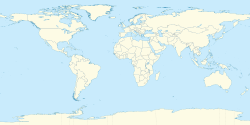An editor has nominated this article for deletion. You are welcome to participate in the deletion discussion , which will decide whether or not to retain it. |
This article needs additional citations for verification .(August 2025) |
The geographical centre of Earth is the geometric centre of all land surfaces on Earth. Geometrically defined it is the centroid of all land surfaces within the two dimensions of the Geoid surface which approximates the Earth's outer shape. The term centre of minimum distance [1] specifies the concept more precisely as the domain is the sphere surface without boundary and not the three-dimensional body.
Contents
Explained in a different way, it is the location on the surface of Earth where the sum of distances to all locations on land is the smallest. Assuming an airplane with infinite energy and resources, if one were to fly from one start location to any location on land and back again, and repeat this from the same start location to all possible destinations, the starting location where the total travel distance is the smallest would be the geographical centre of Earth.
Its distance definition follows the shortest path on the surface of Earth along the great circle (orthodrome).


